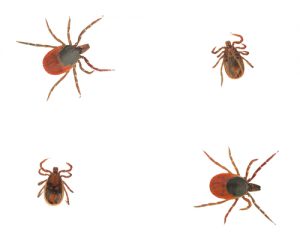Protecting Your Family From Ticks – Advice From the Pros
By Chris Williams on April 9, 2012.
With the warm winter and spring that we’ve had, it’s not too early to start thinking about tick prevention. It’s already been predicted by some experts that 2012 will be the worst year ever for Lyme disease. Lyme disease and babesiosis are transmitted to people by bacteria from the bite of an infected blacklegged (deer) tick. These ticks are the second most common ticks in New Hampshire. The most common tick in our region is the American dog tick that can spread Rocky Mountain spotted fever and other diseases, but does so rarely in our area. Lyme disease from the blacklegged tick is our main concern. 
When your family spends time outdoors, even in your own yard, you and your children are at risk of Lyme or other disease from a tick bite. It’s most important to keep ticks off of you and your children and pets. If you discover an attached tick, remove it immediately. Ticks usually have to be attached for 24 hours to transmit disease. Protect your family with these precautions:
- Wear light-colored clothes to see ticks more easily.
- Wear long sleeves and long pants; tuck pants’ legs into socks or boots.
- When in tick areas, wear high boots or closed shoes that cover your feet completely.
- Wear a hat.
- Use tick repellents.
- Avoid areas with tall grass or heavy brush.
- Shower soon after being in a tick area and examine your body for ticks.
- Be sure to check your neck and head; ticks crawl upward.
- Wash and dry clothes worn outside at high temperatures.
- Remove any attached ticks promptly and carefully with fine-tipped tweezers by gripping the tick and pulling gently. Do not use petroleum jelly, a hot match, or nail polish to remove a tick.
- Save the attached tick in a small bottle of alcohol. Write the date and location of the bite in pencil on a small piece of paper and add it to the bottle.
- If the person develops a bulls-eye rash or flu-like symptoms, see a physician and take the saved tick along.
There is a connection between the numbers of blacklegged ticks and rodents and deer. The immature stages of the tick feed mostly on mice and birds. Adult ticks feed mainly on deer. All of these stages will climb up weeds or shrubs to wait for a host to pass by. Sometimes that host is a person. This is why homes that are in edge habitat, with yards bordering on woods that contain deer and smaller animals, have the highest incidence of blacklegged ticks.
You can help tick-proof your own yard by taking steps to keep a safe zone between your family and the perimeter of your yard and any areas where rodents might nest. Trim high grass and weeds, clear dense brush, and remove wood and brush piles where rodents nest. Keep a mowed or gravel strip between lawn play areas and dense brush, mow a clear strip at the sides of paths, and keep play equipment away from the wood’s edge.